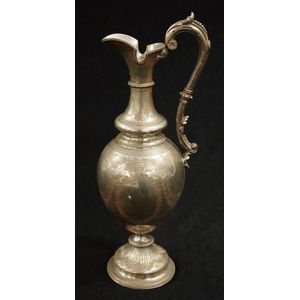Victorian Sterling Silver Claret Jug with Engraved Decoration
You must be a subscriber, and be logged in to view price and dealer details.
Subscribe Now to view actual auction price for this item
When you subscribe, you have the option of setting the currency in which to display prices to $Au, $US, $NZ or Stg.
- Victorian Period - The Victorian period of furniture and decorative arts design covers the reign of Queen Victoria from 1837 to 1901. There was not one dominant style of furniture in the Victorian period. Designers used and modified many historical styles such as Gothic, Tudor, Elizabethan, English Rococo, Neoclassical and others, although use of some styles, such as English Rococo and Gothic tended to dominate the furniture manufacture of the period.
The Victorian period was preceded by the Regency and William IV periods, and followed by the Edwardian period, named for Edward VII (1841 ? 1910) who was King of the United Kingdom and the British Dominions and Emperor of India for the brief period from 1901 until his death in 1910. - Engraving - The method of decorating or creating inscriptions on silver and other metal objects by marking the surface with a sharp instrument such as a diamond point or rotating cutting wheel.
- Ewer / Pitcher - A type of jug with a narrow neck bulbous body and wide spout, originally used for carrying and storing liquids such as water or wine. In medieval times they were the source of water to wash ones hands during and after a meal. later the shape was used for vessels in silver, gold, glass and ceramics.
In Victorian times they were made in ceramics and occasionally glass with a matching basin, and sometimes other accessories such as a soap holder or toothbrush holder. Their purpose was to provide facilities for personal washing In the early 19th century were often enclosed in purpose built stands, and later resided on a washstand..
Sometimes the words "ewer" and "pitcher" are used interchangably, but a pitcher is generally considered to be a jug, and would have a wide mouth, and a gently tapering body. - Sterling Silver - Sterling silver is a mixture of 92.5% pure silver and 7.5% of another metal, usually copper. Fine silver is 99.9% pure silver, and is relatively soft and the addition of the very small amount of copper gives the metal enough strength and hardness to be worked into jewellery, decorative and household objects.
This item has been included into following indexes:
Visually similar items

A Victorian silver wine jug, Alexander Macrae, London, 1871, of ewer form with everted spout, leaf capped scrolling handle, engraved foliae motif throughout, a vacant cartouche to each side, beaded borders, 754 gms, 35.5 cm high

English hallmarked sterling silver Victorian ornate claret jug with a pull down mechanism, armorial spout, three ring panel neck with various floral patterns & motifs, the body is is decorated with bouquets & overflowing floral baskets & stamped with two b

A Victorian sterling silver claret jug Martin, Hall & Co / London /, circa 1881 inscribed 'Victoria Yacht Club/ Prize / 1ST Prize Yacht Race Won By Mr Phipps Turnbulls / Cutter/ Taniwha / 29th April, 1882', approximately 1282 gms silver, 36.5 cm high

A George III silver creamer, ovoid shape raised on circular spreading foot and with flying S-scroll handle, the body embossed with foliate designs and vacant cartouche. London 1817. 70gms. Height 11.5 cm
